| Weight | 1 lbs |
|---|---|
| Dimensions | 9 × 5 × 2 in |
| host | mouse |
| isotype | IgG2b |
| clonality | monoclonal |
| concentration | concentrate, predilute |
| applications | IHC |
| reactivity | human |
| available size | 0.1 mL, 0.5 mL, 1 mL concentrated, 7 mL prediluted |
mouse anti-CD33 monoclonal antibody (PWS44) 6087
Price range: $160.00 through $528.00
Antibody summary
- Mouse monoclonal to CD33
- Suitable for: Immunohistochemistry (formalin-fixed, paraffin-embedded tissues)
- Reacts with: Human
- Isotype:IgG2b
- Control: Spleen
- Visualization: Cytoplasmic
- 0.1, 0.5, 1.0 mL concentrated, 7 mL prediluted
mouse anti-CD33 monoclonal antibody PWS44 6087
| target relevance |
|---|
| Protein names Myeloid cell surface antigen CD33 (Sialic acid-binding Ig-like lectin 3) (Siglec-3) (gp67) (CD antigen CD33) |
| Gene names CD33,CD33 SIGLEC3 |
| Protein family Immunoglobulin superfamily, SIGLEC (sialic acid binding Ig-like lectin) family |
| Mass 39825Da |
| Function FUNCTION: Sialic-acid-binding immunoglobulin-like lectin (Siglec) that plays a role in mediating cell-cell interactions and in maintaining immune cells in a resting state (PubMed:10611343, PubMed:11320212, PubMed:15597323). Preferentially recognizes and binds alpha-2,3- and more avidly alpha-2,6-linked sialic acid-bearing glycans (PubMed:7718872). Upon engagement of ligands such as C1q or syalylated glycoproteins, two immunoreceptor tyrosine-based inhibitory motifs (ITIMs) located in CD33 cytoplasmic tail are phosphorylated by Src-like kinases such as LCK (PubMed:10887109, PubMed:28325905). These phosphorylations provide docking sites for the recruitment and activation of protein-tyrosine phosphatases PTPN6/SHP-1 and PTPN11/SHP-2 (PubMed:10206955, PubMed:10556798, PubMed:10887109). In turn, these phosphatases regulate downstream pathways through dephosphorylation of signaling molecules (PubMed:10206955, PubMed:10887109). One of the repressive effect of CD33 on monocyte activation requires phosphoinositide 3-kinase/PI3K (PubMed:15597323). {ECO:0000269|PubMed:10206955, ECO:0000269|PubMed:10556798, ECO:0000269|PubMed:10611343, ECO:0000269|PubMed:10887109, ECO:0000269|PubMed:11320212, ECO:0000269|PubMed:15597323, ECO:0000269|PubMed:28325905, ECO:0000269|PubMed:7718872}. |
| Subellular location SUBCELLULAR LOCATION: [Isoform CD33M]: Cell membrane {ECO:0000269|PubMed:10611343, ECO:0000269|PubMed:28747436}; Single-pass type I membrane protein.; SUBCELLULAR LOCATION: [Isoform CD33m]: Peroxisome {ECO:0000269|PubMed:28747436}. Note=CD33m isoform does not localize to cell surfaces but instead accumulates in peroxisomes. {ECO:0000269|PubMed:28747436}. |
| Tissues TISSUE SPECIFICITY: Monocytic/myeloid lineage cells. In the brain, CD33 is mainly expressed on microglial cells. |
| Structure SUBUNIT: Homodimer; disulfide-linked (PubMed:10887109). Interacts with PTPN6/SHP-1 and PTPN11/SHP-2 upon phosphorylation (PubMed:10206955, PubMed:10556798). Interacts with C1QA (via C-terminus); this interaction activates CD33 inhibitory motifs (PubMed:28325905). {ECO:0000269|PubMed:10206955, ECO:0000269|PubMed:10556798, ECO:0000269|PubMed:10887109, ECO:0000269|PubMed:28325905}. |
| Post-translational modification PTM: Glycosylated. Glycosylation at Asn-100 is critical for regulating ligand recognition. {ECO:0000269|PubMed:8702538}.; PTM: Phosphorylation of Tyr-340 is involved in binding to PTPN6 and PTPN11. Phosphorylation of Tyr-358 is involved in binding to PTPN6. LCK phosphorylates Tyr-340 efficiently and Tyr-358 to a lesser extent. {ECO:0000269|PubMed:10206955, ECO:0000269|PubMed:10556798, ECO:0000269|PubMed:10887109}. |
| Domain DOMAIN: Contains 2 copies of a cytoplasmic motif that is referred to as the immunoreceptor tyrosine-based inhibitor motif (ITIM). This motif is involved in modulation of cellular responses. The phosphorylated ITIM motif can bind the SH2 domain of several SH2-containing phosphatases. |
| Target Relevance information above includes information from UniProt accession: P20138 |
| The UniProt Consortium |
Data
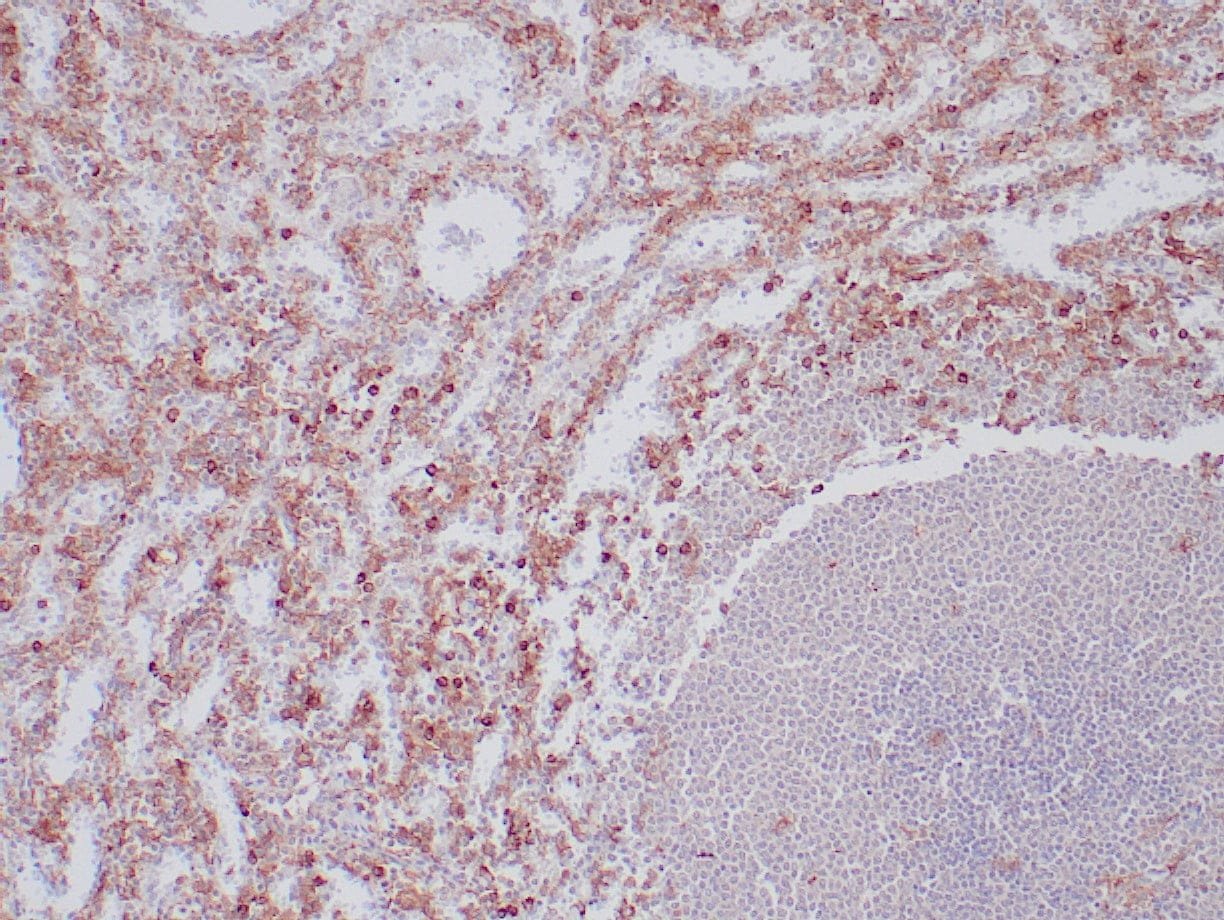 |
| Formalin-fixed, paraffin-embedded human spleen stained with anti-CD33 antibody using peroxidase-conjugate and DAB chromogen. Note cytoplasmic staining of myeloid cells |
Publications
| pmid | title | authors | citation |
|---|---|---|---|
| We haven't added any publications to our database yet. | |||
Protocols
| relevant to this product |
|---|
| IHC |
Documents
| # | SDS | Certificate | |
|---|---|---|---|
| Please enter your product and batch number here to retrieve product datasheet, SDS, and QC information. | |||
Only logged in customers who have purchased this product may leave a review.
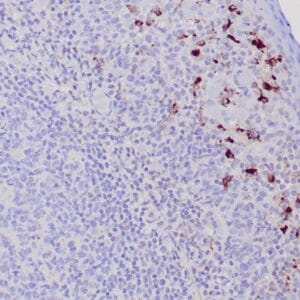
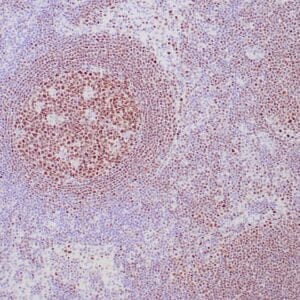
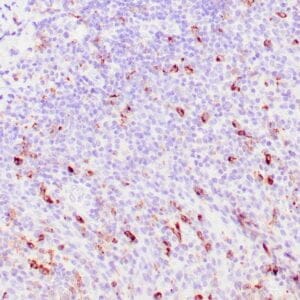
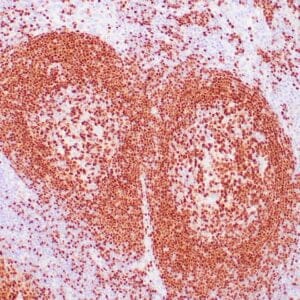

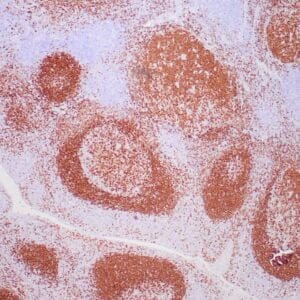
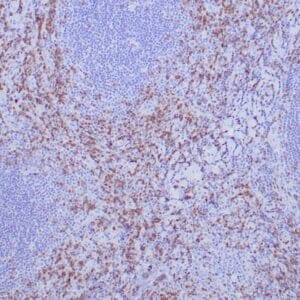
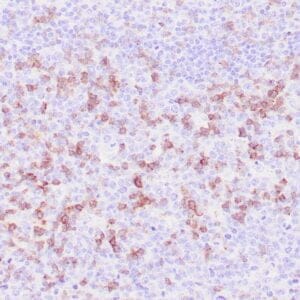
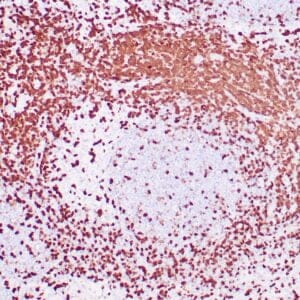



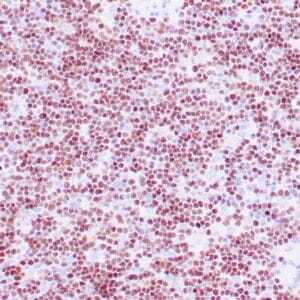


Reviews
There are no reviews yet.